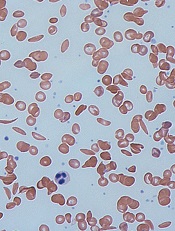
Image by Graham Beards
The UK’s National Institute for Health and Care Excellence (NICE) is asking for views on its plans to recommend a device that automatically replaces sickled red blood cells (RBCs) with healthy RBCs in patients with sickle cell disease (SCD).
NICE has issued a draft medical technology guidance supporting use of the Spectra Optia Apheresis System for automated RBC exchange in patients with SCD who need regular transfusions.
The guidance is open for comment until November 16.
The Spectra Optia system is made up of 3 components: the apheresis machine, embedded software, and a single-use disposable blood tubing set. The system is manufactured by Terumo.
NICE said the evidence examined indicates that the Spectra Optia system speeds up the process of RBC exchange compared to manual RBC exchange.
The evidence also suggests that patients require RBC exchange less frequently when using this system than they do with manual RBC exchange.
Furthermore, the Spectra Optia system is estimated to provide cost savings for most patients, when compared to manual RBC exchange or top-up transfusion.
Potential savings depend on the patient’s clinical circumstance and if devices already owned by the National Health Service can also be used to treat SCD.
However, NICE’s draft guidance also highlights a need for additional data on treatment outcomes, as there is limited clinical evidence for some outcomes.
“In particular, the independent Medical Technologies Advisory Committee would like to see long-term data on how manual and automated cell exchange affects the amount of iron in the body and the need to treat this complication,” said Carole Longson, director of the NICE Centre for Health Technology Evaluation. “We welcome comments on the draft guidance as part of this consultation.”


